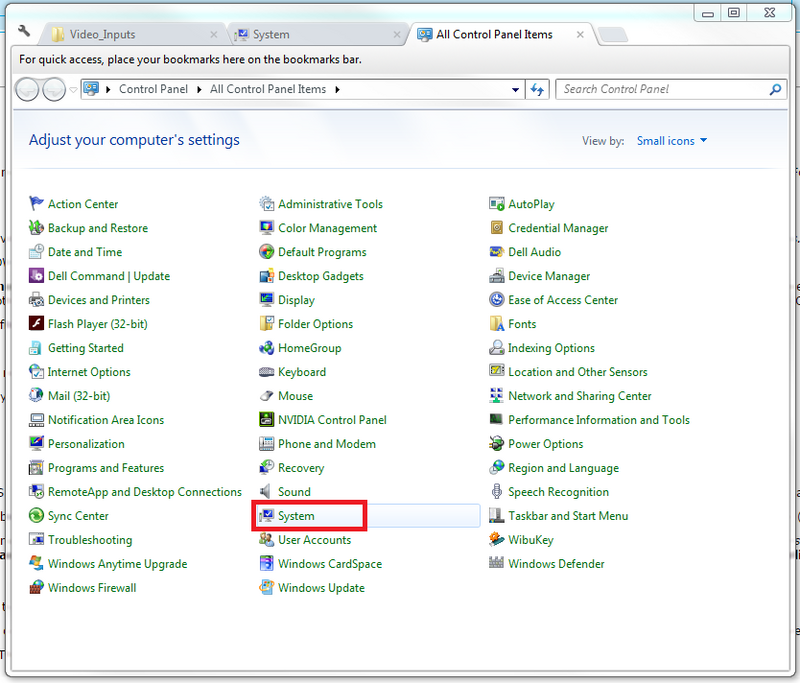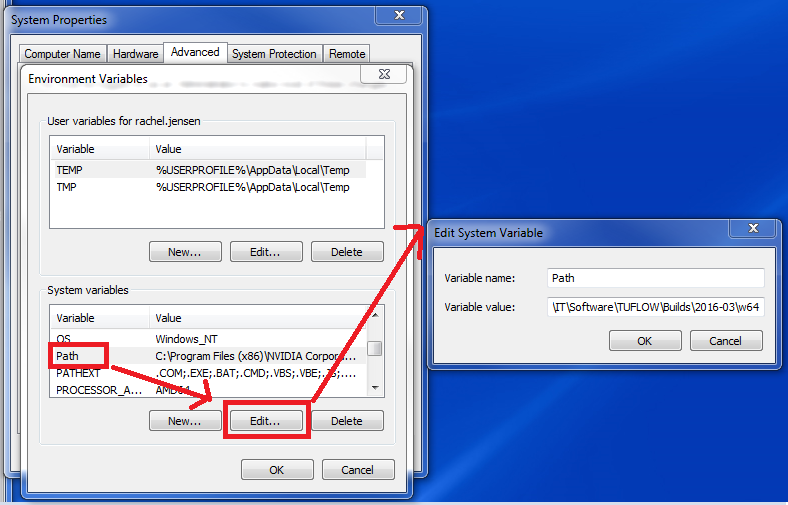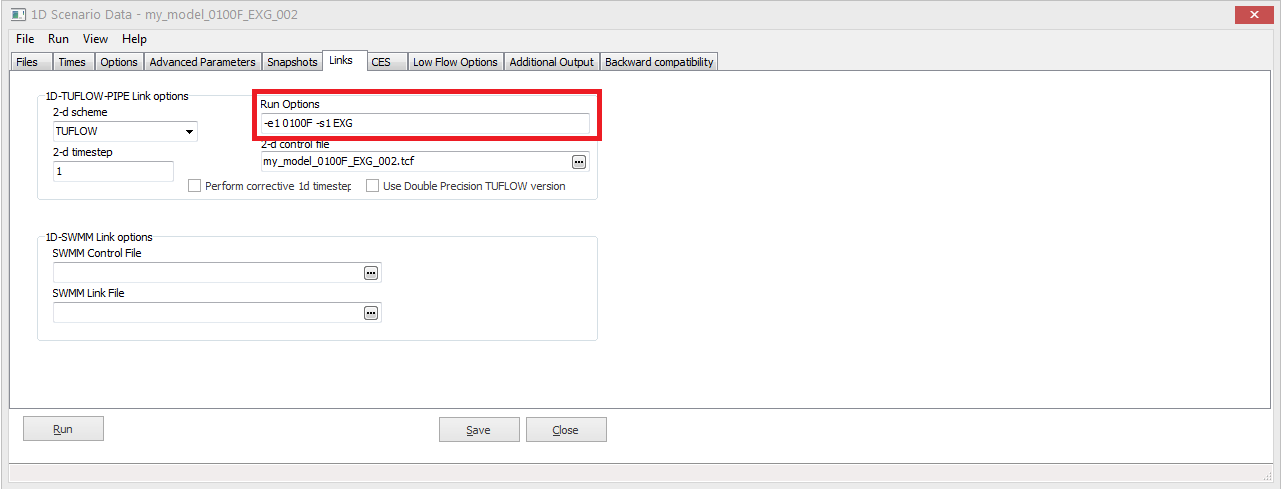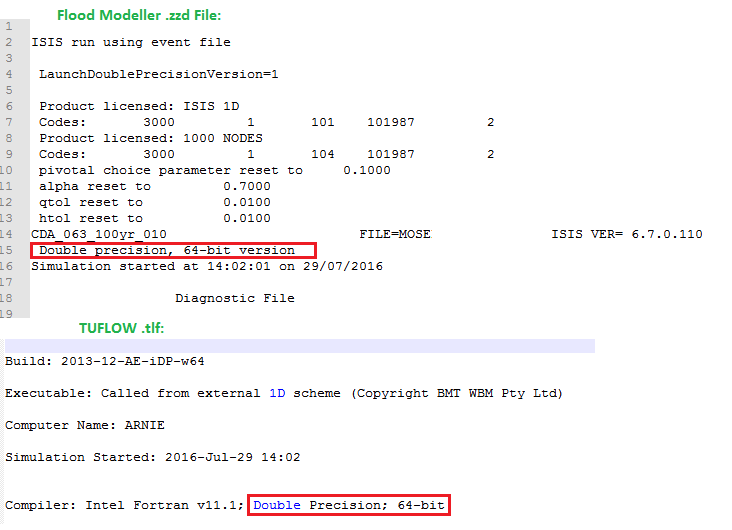Running linked Flood Modeller - TUFLOW Models
Introduction
There are several different ways to run a linked Flood Modeller-TUFLOW or ISIS-TUFLOW model.
This wiki page is intended to guide the user through the main methods of installing the link correctly and provide information on troubleshooting.
Other resources for installation help include:
- Installing a TUFLOW dongle
- Running a TUFLOW Model
- Installing Flood Modeller
- Installing ISIS (for backwards compatibility)
Flood Modeller Free and TUFLOW Free permit the running of linked models. Both Flood Modeller and TUFLOW Free versions have limitations on model size and simulation run time.
Licensing considerations for running linked models have not been considered in this section. It was been assumed that the User has purchased the Flood Modeller-TUFLOW link module or is making use of the free versions.
Methods to Run Linked Flood Modeller-TUFLOW models
The three main methods for installing Flood Modeller and TUFLOW to run linked models are detailed below. It is assumed for all methods that Flood Modeller has already been installed and TUFLOW has been downloaded.
Set an Environment Variable
Setting TUFLOW as an environment variable allows for simple installation and minimises duplication of files. This method is recommended if it is expected that the same versions of Flood Modeller and TUFLOW will be used consistently when running linked models.
1) Click on the start button in windows and open the Control Panel. In the Control Panel, navigate to System.

2)Click on Advanced Systems Settings. In the Advanced tab, click Environment Variables.

3) Under System Variables, click on the Path Variable and select Edit.
In the dialog box, under Variable value, add a semi-colon after the current text and then the full file path to the location of the TUFLOW executable.
4) The linked model may be run by by opening the .ief file within the Flood Modeller Interface and clicking Run.

Batch File
This method allows the user the flexibility to simulate models using different version of Flood Modeller and TUFLOW on the same computer.
After setting up this method the model is run through a batch file. The benefit of this method is that it allows for the running of multiple simulations.
1) Using a file explorer, navigate to the location of the TUFLOW executable files. Copy all of the files either within the 'w32' folder or 'w64' folder depending on whether the 32 bit or 64 bit version of Flood Modeller has been installed on the computer.

2) Navigate to the location on the local drive where Flood Modeller has been installed. In this case, it is C:\Program Files\Flood Modeller although your path may differ depending on your system and installation.
Paste the copied TUFLOW files into the bin folder. If asked, copy and replace the files.
3) To set up this method for multiple versions of Flood Modeller and TUFLOW:
- Create an empty folder and appropriately rename it to denote the versions of Flood Modeller and TUFLOW.
- Copy the entirety of the 'bin' folder from the version of Flood Modeller that you wish to use.
- Paste this 'bin' folder inside the newly created folder.
- Copy and paste in all TUFLOW executable files from the version that you wish to use inside the 'bin' folder. Remember to ensure either the 32-bit or 64-bit executables are copied. These need to be compatible with the version of Flood Modeller used.
To run linked Flood Modeller-TUFLOW models with this method, create a batch file.
- In a text editor, paste the path to the Flood Modeller executable file (ISISf32.exe for single precision and ISISf32_DoubleP.exe for double precision) and the name of the .ief file. It may be necessary to include the filepath if the .ief file is not saved in the same folder as the batch file.
- Add the optional batch switch '-sd'. This is useful when running multiple simulations as it allows for the simulation to automatically shutdown on completion removing the need for any user intervention.
- Double click on the batch file in a file explorer to start the simulation.
Flood Modeller Batch File (IPF)
The Flood Modeller batch file can be used to set up multiple batch runs of Flood Modeller-TUFLOW linked models.
Refer to the following guidance document on the Flood Modeller website for further information [1]
Using TUFLOW Events and Scenarios when Running Linked Models
The Events and Scenarios feature within TUFLOW can be used when running linked models. Further information on this feature may be found within this presentation and in the TUFLOW example models.
Each unique Flood Modeller - TUFLOW simulation will still require its own .ief file. However, each of these .ief files may refer to the same TUFLOW .tcf control file. The TUFLOW Event or Scenario is specified within the 'Run Options' Section of the 'Links' tab within the .ief file.
In the below example, the .ief file is named 'my_model_0100F_EXG_002.ief'. It references a TUFLOW .tcf file named 'my_model_~e1~_~s1~_002.tcf'.
By adding '-e1 0100F -s1 EXG' to the 'Run Options' box, the '0100F' event and the 'EXG' scenario is selected by TUFLOW.

Getting the Correct Version (Single vs Double Precision, 32 vs 64 Bit)
A common error encountered with running linked Flood Modeller-TUFLOW models is inconsistency between versions.
These errors will typically cause the model run to fail before the simulation has commenced.
There are two factors to getting this correct:
1) 32 or 64 bit versions
Both TUFLOW and Flood Modeller have 32 and 64 bit versions.
When you install Flood Modeller, you will be prompted to choose which type, and you should pick the one that matches your computer.
When you run TUFLOW, you can choose which one you would like to run, by selecting the _w32 or _w64 folder in the TUFLOW downloads pack.
Whichever method of running linked Flood Modeller-TUFLOW you chose in the above section, it is important that the 32 or 64 bit versions match.
Do this by ensuring that the TUFLOW executable you make your environment variable or run in your batch file always is right (either _w32 or _w64) for your computer.
2) Single vs Double Precision
Both TUFLOW and Flood Modeller have Single and Double precision versions. In short, these refer to how many decimal points are used to do the calculations.
Depending on the model, it can be useful to be able to run either precision version.
Ch2m have provided practical guidance on the use of Double Precision in legacy versions of ISIS.
Whichever precision version and method you're using to run Flood Modeller -TUFLOW models, we recommend always ensuring that there is consistency between the packages.
You can check this by reviewing the first lines of your Flood Modeller .zzd file and your TUFLOW .tlf file.


